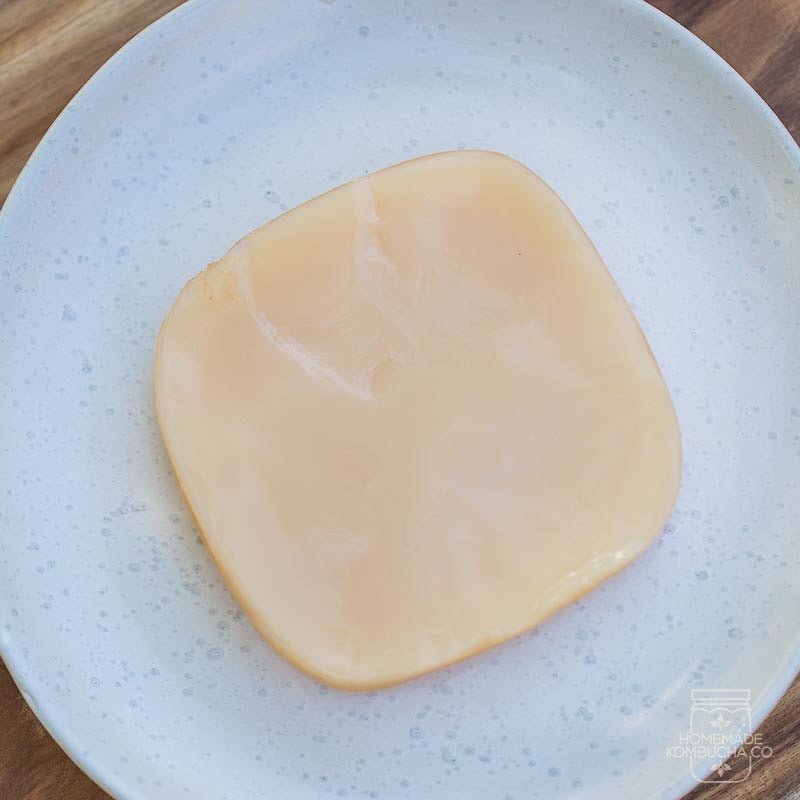This is probably the biggest question for anyone who has just started making their own homemade kombucha – ‘what does a healthy SCOBY look like?’.
We already know from our other blog posts – what a SCOBY is and tips for looking after a SCOBY. However, there are times where is may be difficult to tell if a SCOBY is normal, if it is healthy, and most importantly if your fresh, homemade kombucha is safe to drink.
To help all of you taking your first homemade kombucha steps – we have prepared this quick blog post with some behind the scenes photos from our own brews at the Homemade Kombucha Co.
SCOBYs are not necessarily the most attractive things, and a quick hunt through Google images will quickly show you that they can some in all shapes, sizes and colours.
Normally a SCOBY will be somewhere between a tan brown and a creamy white colour. The surface may be smooth, uneven, have holes or even bubbles – these are all pretty standard variations. You would consider a SCOBY mature once it is about 1cm thick or more, if you have followed your kombucha brewing instructions, and your brewing space is not too cold, the SCOBY should reach this thickness after roughly two weeks.
When you use a ‘mother’ SCOBY like the ones we sell, it should create a ‘baby’ once your brew is ready. In most cases the baby will have fused with the mother SCOBY, sometimes this will be a perfect, symmetrical bond, and other times it may be a partial bond with the mother hanging off the newly formed baby SCOBY. In either case, this is fine – keep them bonded together to brew your next batch of kombucha, or carefully separate them without using metal and try to avoid using your hands.

The most concerning thing from the inexperienced kombucha brewer is usually dark coloured strings, blobs and patches hanging from the SCOBY. These are strands coming from the yeast – they are unattractive but normal. We strongly recommend you strain these out of your brew using a metal-free strainer like this, before drinking – the strands are pretty slimy!

This SCOBY is what you would consider a ‘perfect’ specimen, a light cream colour, with good thickness and an even surface. This is the sort of SCOBY you will usually see in photos – but don’t worry if your SCOBY isn’t this pretty, it will still ferment quality kombucha for you. Note the square shape with rounded edges – the SCOBY will mould into the shape of the brewing container.


A nice, cream colour with an uneven surface. It was likely that the SCOBY was partially submerged causing the ridges on the surface.

A relatively smooth surface, light colour on top, and dark underneath. The tannins from the black tea have stained the SCOBY a darker, brown where it was in contact with the brew.

This SCOBY has been stained by the tea tannins, it would have sunk and been completely submerged in the kombucha to make it this colour.

A large SCOBY, grown in a big jar – it has also been stained by the tea. Green tea SCOBYs usually will be a lighter colour than this.

The bubbles in the surface of this SCOBY are relatively common – this is usually because of the gases released during the fermentation process.

This has a large ‘mother’ SCOBY that has fused with the new ‘baby’. The baby is a much lighter colour because it was not submerged, and stained by the tea.

Brown colour is the result of tea tannin stains. A brown yeast strand is visible – these are normal, but you still may like to remove them from time to time.

This is a pretty good specimen. Generally you would expected lighter coloured teas to produce a SCOBY with this creamy colour.

This is an example of a poor quality SCOBY – thin and flimsy means it will easily rip or may have holes in it just from the gases escaping during the fermentation process. The colour of this SCOBY isn’t an issue – that is just the result of stains from the tea. The dark brown patches are from the yeasts – this is normal.
Overall a SCOBY that looks like this will still produce kombucha, but it suggests that something is slightly off – the most likely explanation is that the temperatures were a bit too cold.
When your kombucha and the SCOBY have been contaminated by harmful bacteria or mould it is usually pretty obvious. If things smell rotten and cheesy something has gone wrong.


If there are any growths that look fuzzy – either white, green, brown or black, then you have mould contamination. Mould problems are usually the result of not following instructions, and allowing the pH to become too neutral. Use these pH strips to test your brew and avoid losing your kombucha and your SCOBY.
If you still have a few questions about the appearance of your SCOBY or your kombucha brew – check out the FAQs as well.

